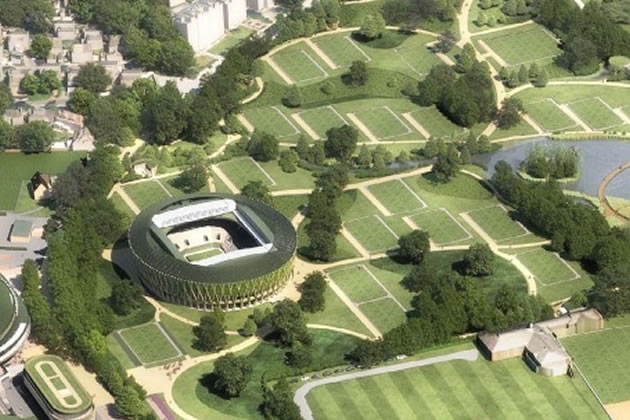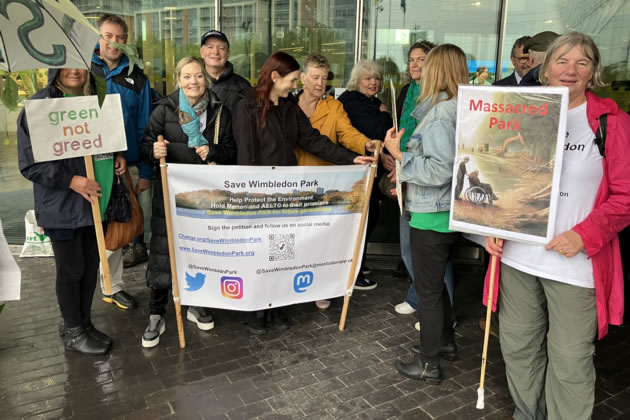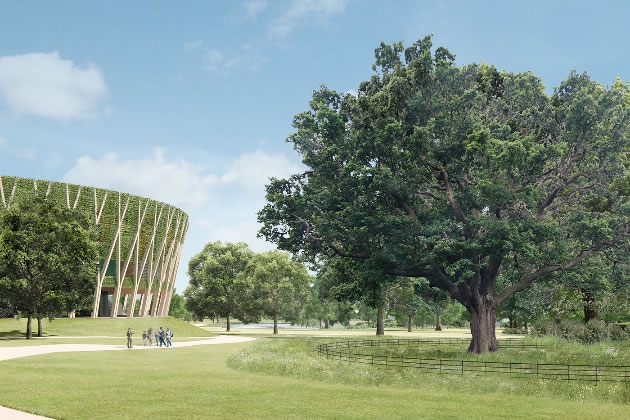Judicial Review Confirmed for Wimbledon Tennis Plans
High Court accepts that arguments against scheme 'merit consideration'

CGI of the aerial view of the completed scheme. Picture: AELTC
February 19, 2025
Plans to triple the size of the Wimbledon Tennis Championships’ grounds will be subject to a judicial review, the High Court has confirmed.
Permission for the scheme – which will see 38 practice courts and an 8,000-seater stadium built on a golf course across the road from the Championships’ existing site – was granted by London’s deputy mayor for planning, Jules Pipe, in September last year.
But that permission was legally challenged by local campaigners, who argue that City Hall “made errors of law and planning policyâ€, as it “failed to take into account the implications of the statutory public recreation trust and the restrictive covenants [on the land], both of which prevent the proposed developmentâ€.
Two further grounds for challenge, relating to the land’s status as a “historic heritage asset†and as a site for “recreational provisionâ€, were also put forward.
It has been revealed that the court has accepted all three of the campaigner’s grounds for a judicial review, with Mrs Justice Lang saying that their submission had “raised arguable grounds which merit consideration at a full hearingâ€. A date will now be set for a hearing, though it is unlikely to take place for several months.
The All England Lawn Tennis Club (AELTC), who run the annual championships, said, “Our plans to transform land that was formerly a private members’ golf club into beautiful new publicly accessible parkland, as well as securing the future of The Championships for generations to come, has been extensively discussed and analysed over the past three years.
“We are confident in the process undertaken during this time, including the GLA’s [Greater London Authority] decision to grant planning permission at a public hearing in September.â€
Jeremy Hudson, who is part of the Save Wimbledon Park (SWP) campaign opposed to AELTC’s plans, said. “This is a significant milestone as we seek to encourage AELTC to think again and comply with legal policies and obligations. However, we firmly believe that disputes are best settled by discussion, not by resorting to lawyers and the courts.â€

Opponents of the plan demonstrate outside the original hearing at City Hall. Picture: Save Wimbledon Park
The campaign ultimately hopes to follow an example set in Shropshire in 2023, where a housing development was overturned on the grounds that a statutory trust created in 1926 gave residents rights of recreation over the land.
Before taking a decision on the application earlier this year, City Hall sought its own legal advice on the issue, which found that “the land is held subject to a statutory trust for its use for public recreationâ€. City Hall’s officers added however that “the matter is far from clear cut, and there are arguments pointing in both directionsâ€.
Shortly before Christmas, AELTC made the surprise announcement that it would take the ‘statutory trust’ question to the High Court itself, in an attempt to prove that no such issue stands in the scheme’s way. It is understood that this separate litigation had not yet begun, though it is possible that once it does, there could be two court cases running at the same time.
A spokesman for mayor Sir Sadiq Khan said in January, “The mayor believes this scheme will bring a significant range of benefits including economic, social and cultural benefits to the local area, the wider capital and the UK economy, creating new jobs and cementing Wimbledon’s reputation as the greatest tennis competition in the world.
“It is understood that an application has been made for the court to determine this matter and it is therefore inappropriate for the mayor to comment further at this stage.â€
Responding to the news that SWP has launched its own legal action against the Greater London Authority (GLA), a spokesman for mayor Sadiq Khan said: “The mayor believes this scheme will bring a significant range of benefits including economic, social and cultural benefits to the local area, the wider capital and the UK economy, creating new jobs and cementing Wimbledon’s reputation as the greatest tennis competition in the world.
“It is understood that an application has been made for the court to determine this matter and it is therefore inappropriate for the mayor to comment further at this stage.â€
AELTC has been named as an “interested party†in SWP’s challenge, as have Merton and Wandsworth councils – each of which considered the planning application before it reached City Hall.
AELTC declined to comment on the SWP’s legal challenge, but said in December: “The possibility of a statutory trust on the land was raised by the GLA in their officers’ report and the issue was dealt with appropriately by the GLA in granting planning consent.
“Our position, and that adopted by Merton Council on advice, was and remains that there is not, nor has there ever been, a statutory trust affecting the former Wimbledon Park Golf Course land.â€
It added that the project “will maintain our position at the pinnacle of tennis†while delivering “year-round benefits for local people with 27 acres of newly accessible parkland for everyone to enjoyâ€.
It is understood that a judge will now review all of the papers that have been filed by SWP and the other named parties, and will then decide whether or not to grant permission for a judicial review to take place. SWP estimates that a decision on whether to take the case forward could be reached within two or three months, and a full trial could then take place in approximately 12-18 months from now.
The golf club land was sold to AELTC by Merton Council in 1993, during which time the authority imposed a set of restrictive covenants to preserve the openness of the land. Approached for comment on SWP’s legal challenge, which refers to those covenants, Merton pointed to a statement it issued when City Hall granted planning permission in September.
The council said at that time that “the granting of planning permission does not override the covenants†and it “intends that the covenants be respectedâ€, while refusing to say anything further on the matter at this stage.
Wandsworth Council leader Simon Hogg said: “We share the view of local residents that the plans are damaging to the environment and are therefore not right for our community. Protecting the environment and access to green spaces are issues we are committed to. We will continue to liaise with residents and campaigners to ensure that the voices of those in Wandsworth are heard.â€

CGI of the completed scheme. Picture: AELTC
In November, the campaign against the project, Save Wimbledon Park, announced that it had secured the status of a limited company, in order “to progress any future legal action that may be advisedâ€.
The new company said it had already instructed the Putney-based firm of solicitors Russell-Cooke to advise on its legal strategy for challenging AELTC.
A spokesman for Save Wimbledon Park Ltd said, “We have been pointing out for a considerable time that the statutory public recreation trust on which AELTC hold the heritage golf course land is a fundamental block on the proposed development, and that AELTC need to think again.
“We are glad to hear that AELTC now recognise our point of view and note that they wish to take this to litigation rather than engage in any discussion.â€
Noah Vickers - Local Democracy Reporter